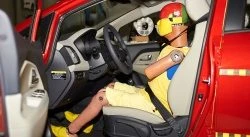
In our second article depicting the ins and outs of the Insurance Institute for Highway Safety, we are taking a closer look at the crash test dummies used at the Vehicle Research Center. The IIHS performs numerous crash tests on vehicles and in almost every crash, a test dummy is required. These crash test dummies work by depicting exactly what would happen to a human if they were involved in a similar automobile accident.
The IIHS employs a specific person just to ensure that all crash test dummies are calibrated and ready for testing. This person is the Dummy Calibration Lab Manager. The general idea behind a calibration is to ensure that dummies used at the Institute will react in the same way as a dummy used in other test labs. It also provides repeatability from test to test and ensures they will react the same as a human in car wrecks. The calibration test consists of head drops, thorax impacts, knee impacts, and rear impacts.
Because no single crash test dummy is able to be used in all crash tests, the IIHS uses three types of dummies: frontal impact dummies, side impact dummies, and rear impact dummies. There are also different sizes, ranging from a six-month-old infant to a 95 th percentile male. The 95 th percentile male crash test dummy is larger than 95% of the population. The VRC’s work horse is the Hybrid III 50 th percentile male crash test dummy. He stands 5’10” tall and his weight is 172 pounds. He is used in the frontal test programs. The test dummy that used for rear impact testing is called BioRID. He has articulating vertebrae. The BioRID dummy reacts very much like a human and is more suited for rear impact testing than the standard frontal impact dummy. Finally, the SID-IIs is a 5 th percentile female dummy used for side impact testing. It is the size of an average 12-year-old child.
Each crash test dummy used by the IIHS has from 20-40 different sensors within the dummy. These sensors measure forces on and acceleration of body parts, as well as the movement of ribs and deformation of the dummy’s chest. Once fully instrumented, these crash test dummies approach $200,000 in value. Engineers are able to use these measurements to determine how an actual human would be injured in a crash.
The IIHS also uses makeup, or greasepaint, on the dummies. This paint is applied to the crash dummy’s hands, knees, face, and shins prior to a crash test. This allows for points of contact to be determined on the vehicle’s dashboard, doorframe, airbags, and other parts.
Each of the steps taken by the IIHS to measure safety of a vehicle is important. As Marietta auto accident attorneys, we feel that vehicle and crash test dummy testing it is vital to the increased safety of Georgia car wreck victims.
If you or a loved one have been injured in a Georgia auto accident, contact the car wreck lawyers at Jones & Swanson today for a free case evaluation at (770) 427-5498.
Categories: Auto Accidents, Car Accident, Personal Injury




